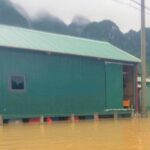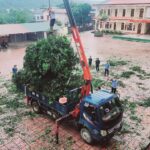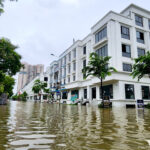As of 9 am on September 19, according to the National Hydro-Meteorological Forecasting Center, the eye of Typhoon number 4 was located at approximately 17.4 degrees North latitude and 108.2 degrees East longitude, about 90 km East of Con Co Island (Quang Tri province) and 120 km Northeast of Hue city.
The strongest winds in the vicinity of the typhoon’s eye were recorded at level 8 (62-74 km/h), with gusts of up to level 11. In the next 3 hours, the typhoon is expected to move primarily in a Western direction at a speed of around 25 km/h.
In Thua Thien-Hue province, there has been widespread heavy rainfall, ranging from 10mm to 30mm, with some areas experiencing longer periods of intense rain, such as Bach Ma National Park, which recorded 39mm. Due to the influence of the tropical depression and the typhoon, from the early morning of September 19 until September 21, the province is expected to experience heavy and very heavy rain, along with scattered thunderstorms. Strong winds, lightning, and flash floods are possible during these storms. Currently, all water reservoirs and hydropower plants in the province are at safe water levels.
On the morning of September 19, several mountainous districts, including A Luoi and Nam Dong, initiated emergency evacuation procedures in anticipation of flooding and landslides. Simultaneously, coastal areas have been experiencing coastal erosion and sea intrusion.
In Hong Ha commune, A Luoi district, 11 households comprising 45 individuals from Pa Hy village were urgently evacuated to safer locations, including the homes of relatives and community buildings. Those with elderly or ill family members were accommodated at the commune’s medical station, with food, water, and other essential provisions supplied.
During the same morning, hundreds of households from Hong Bac, Hong Kim, Hong Thuy, Quang Nham, and Phu Vinh communes were also relocated to safer areas. Notably, in Quang Nham, there were four localized flooding spots and six landslides, causing damage to property. To ensure the safety of the residents, 87 households from Âr Ba Nhâm village and four households from A Hươr Pa E were evacuated to the community house, the local elementary school, and the homes of relatives. The local authorities instructed the support forces to assist with moving belongings, imposed restrictions on people and vehicles passing through dangerous submerged passages, and cleared fallen trees from the roads to maintain accessibility.
In Nam Dong district, during the night of September 18, authorities evacuated 34 households comprising 119 individuals to safer locations. Specifically, in Thuong Long, 16 households with 64 individuals were moved; in Thuong Nhat, three households with 12 members were relocated; and in Khe Tre town, 15 households with 43 members found refuge in secure areas. These were families residing in areas prone to flooding and landslides along hills, mountains, and rivers.
Given the complex developments of Typhoon number 4, the Thua Thien-Hue province’s Steering Committee for Natural Disaster Prevention, Search and Rescue has prepared evacuation plans for 16,349 households, totaling 52,186 individuals, to address the typhoon. Additionally, they have devised evacuation strategies for 3,743 households, or 13,615 individuals, who are at risk of flash floods and landslides.
The province has also stockpiled 100 tons of rice and 100 tons of instant noodles, along with other essential goods, to provide for residents in areas prone to landslides, isolation, and separation. Currently, many low-lying areas in Hue city and surrounding districts are experiencing localized flooding.
In Quang Tri province, several roads in the mountainous districts of Huong Hoa and Dakrong have been temporarily cut off due to deep flooding at several fords, such as Ly Ton, where the water level reached approximately 0.2 meters, and the ford through Loa village in Ba Tang commune, where the water level rose to one meter. In the flooded areas, authorities have erected barriers and strictly prohibited the passage of people and vehicles for safety reasons.

On September 19, the Quang Tri Provincial Department of Education and Training issued a document to the educational units in the province, requesting them to actively respond to Typhoon number 4. Depending on the local situation, heads of units and schools are authorized to allow students to stay home, postpone non-essential meetings and competitions, and, most importantly, ensure the absolute safety of teachers and students participating in the provincial academic excellence competition for grade 12 students in the 2024-2025 school year until the end of this hazardous weather event.
In Quang Binh province, heavy rains during the night of September 18 and through the noon of September 19 caused localized flooding and isolation of several communes in the mountainous border district of Minh Hoa. This weather event particularly affected communes such as Dan Hoa and Trong Hoa.
The rising water levels in rivers and streams led to the inundation and isolation of several roads connecting to border villages in these communes. In K Ai village (Dan Hoa commune), the only access road to the village was flooded, with water levels reaching nearly one meter, rendering it impassable for people and vehicles.
Similarly, at CuPi and Ta Co fords in Trong Hoa commune, erosion and rising water levels of approximately 0.5 to 1 meter resulted in the isolation of two villages. The Cha Lo International Border Gate Border Guard Station and the Ra Mai Border Guard Station, under the Quang Binh Provincial Border Guard Command, collaborated with local authorities to set up warning signs and inform locals not to cross these hazardous areas.

During the night, the Ca Xeng and Ra Mai Border Guard Stations coordinated with local authorities to evacuate 105 households, comprising 506 individuals, from high-risk areas in Trong Hoa, Hoa Son, and Thuong Hoa communes to safer locations. This proactive measure was taken due to the possibility of landslides and flooding in these areas.
Previously, the authorities of Quy Dat town, Minh Hoa district, had also organized the relocation of nearly 40 households living at the foot of Suong Mountain, as this area had been experiencing subsidence and cracking, posing risks of landslides and potential collapse during heavy rains. To cope with Typhoon number 4, the Quang Binh Provincial Border Guard Force maintained 42 teams to monitor the situation on the ground. Additionally, they are prepared to deploy 8 canoes and other necessary equipment to respond to any emergencies that may arise.
The Soaking Deluge: Central Vietnam’s Torrential Rains Leave Hundreds of Homes Submerged
Heavy rainfall battered the central provinces overnight, continuing into the early hours of September 20th. The downpour caused widespread flooding, prompting the swift evacuation of thousands of residents to safer grounds by the authorities.
The Storm’s Fury: How Strong Winds and Heavy Rains Caused Havoc in Thanh Hóa and Nghệ An Provinces
“Super Typhoon No. 4 battered two provinces on September 19, bringing heavy rainfall and strong winds that caused extensive damage and injuries. The storm’s ferocious winds led to several accidents, with large trees snapping and crashing, injuring multiple individuals and resulting in significant property damage.”
“Government-Backed 2000 Billion VND Loan Scheme to Aid Post-Disaster Reconstruction”
Military Commercial Joint Stock Bank (MB) is offering a special loan package of up to 2000 billion VND with a 1% reduced interest rate for individuals and households affected by the floods. This initiative aims to support those impacted by the natural disaster to rebuild their lives and get back on their feet with ease.


![[Photo Essay]: Experts, Managers, and Businesses Unite to Forge a Path Towards Sustainable Green Industry](https://xe.today/wp-content/uploads/2025/07/z678592918-218x150.jpg)





































